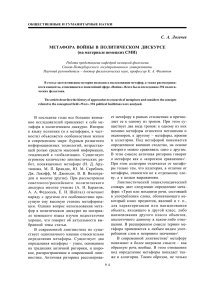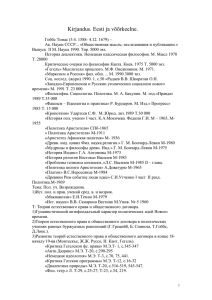Ю. A. Лысцова МУЗЫКА ИРРЕАЛЬНО
advertisement

. . ... , 4. Taktische und strategische F hrung. . « » « ». 9) Weil – so die Sorge - alle Beteiligten ihre Strategie k nftig vor allem unter dem Aspekt der gr tm glichen Fernsehwirkung planen werden. („Herr Fischer, t uscht der Eindruck?”). 10) Doch die in Strategie und Taktik geschulten Genossen wappnen sich l ngst f r den Ernstfall. („Fundamentalismus und Identit t”) , . . . , - . 1 Pielenz M. Argumentation und Metapher. T bingen, 1993. S. 65–66; Schmitt R. Metaphern des Helfens. Weinheim, 1995. S. 69 2 / . . . . . ., 2002. . 296. 3 ke K., St tzel G. ffentlicher Sprachgebrauch. Opladen, 1996; Villwock J. Metapher und Bewegung. Hamburg, 1999. 4 lsse R. Metaphern der EU-Erweiterung als Konstruktionen europ ischer Identit t. Berlin, 2002. S. 25 5 Pielenz M. Op. cit. S. 66 6 . , . ., 1998. . 25. 7 Chilton P. Security metaphors. New York, 1996. 8 lsse R.Op cit. S. 33. 9 . ., . . ( ). ., 1991. . 189. 10 . : . . : (1991–2000). , 2001. . 104–105. 11 , : ster R. Milit rmetaphorik im Zeitungskommentar. G ppingen, 1978. S. 46. 12 . . . . . 109. . . . . , . – . . , – , , 97 . , . . « » : », « », . », « « – - . Perception of music by a person – hearing submodus – is regarded in the article. The analysis of language means shows that it is artistically important in V. Pelevin’s creative works. The characters perceive organised and inorganised sounds as «music». These soundings influence a person in different ways. Some sounds pass by as «empty», «dim» and «cold» ones, others give a person a chance to get in touch with another worlds. . , . , - «… , . - , . : , . - , - »1 . , , , – , , . . . . , - - , » . . . « » - : . » « , , ( ( , « ». , , , ), , ); 4 » . , , : – , , 2 , . : « , ». . - , . » . . - – , , »3 . , . , , . , - - , « , . , « . , . - , , - , , . 98 . . . : . . « », »5 . , . , - , « ? ... .: ». », « – , »7 . « » , ? , », « - », « », « , », « , , , , - , , . » – , . , . . . , . , », « - , », », – .: «… . …»8 . – - : , » – », « », « , . . , . , - , , . . . », « ». .: « - »9 . , – «wa – wa – wa», « – », « » , , – - , .: «… 10 …» . » , »– . », « , , . , , », « - ». - , .: , ( ; . , .: «… – 6 , , …» . - , », « , , , , ». , … , . . – ). »11 . , , , », « . 99 », « - », « », « , », - , ». , , . , , , - » » : « . , , , , » » » - , , , , » , – - . . . »12 . . ( »), , , ( »), ( , » , . »), » . . . - , - , . , .: «… », , » 19 . « , » », « . , . : 13 » ; . », « ( ) », . »14 ; …»15 ; 16 » . », « », - », ». , , ): », « . , » ( , - », « », , . », – - », « « ». .: « , « – » 17 . « « » , « » - : » 20 . » », ». . .: «… , , , . » , . - – », « …»18 . », – 100 - . . . ... » « .: «… »; »21 . », « « », , « », », « . ( », », . . . .: « ») », : », ». , , » », « - – – » . . , . , . . : - , – [ . , 2004: 24]. . , . , , , , . . - , , », »; « »23 ; - »; « » , »; « »; : », « », « », « (= ) », « ». .: «… … , »25 . », « », « , , »24 ; ». », « », « », « » », « », « », « , : - : », « ». - , , , « - . , », « »; « », « », « , … , : ». : », « .: « , - »26 . . : – »; « .; » . - , », , - , ». – « - , . – » »; « »; » »; .; » – – »; - »; « » …»22 . , - … .; .; », , ». »: « .; – …»27 . , », « 101 , - » . , - . . », « 28 », « » » », « » » » .: «… , , », « .« - . ». - …»30 . . , . , , - , , , : « , », « : « », « », « » « », « , ) », « ». .: «… , , , « 1 . , 3 4 . . . », 5 ( 6 . . 7 8 9 10 11 12 . . 13 14 15 16 17 18 19 20 . . . . . . . . . . 189. . 370. . . . . . 46. . 47. . . . . . . . . ) , , . . . : // . 1994. 4 ./ . . . . ., 2005. . 141. . ., 2003. . 67–68. . – ., 2005. . 148. . ., 2003. . 83. . ., 2005. . 134. . . . . . ) . . : . , ( ) . 87. . . . . » . , »29 . 2 , . » » , », « , – », », « ». » ( , « ». ., 2003. . 418. ., 2005. . 47. . 155. . 138. . . 164. ., 2005. . 148. 102 : . ( 6. , . 79. , 2000. , 4 . ., 1989–1991. ., 1981–1982. . 30. , . . 21 22 . . . 363. . . . . 23 24 . 27 28 . . 30 . 239. ., 2005. . 249. // - . 24. . . 29 » : . . . 28. . 28. . . ., 2003. . : , 2004. 25 26 « ». « . 409. . . . . ., 2002. . 59. « ». . 313. . . 112. . . . . « » . – , . . . . « ». . . . . « , ». – , – . The article is devoted to the analysis of poetics of N. Aliyev’s drama «Father shot himself». The dramatist’s skillful use of the retrospect technique intensifies the dramatic collision. The playwright managed to reveal the characters’ inner world through the dialogues. The method of «inflow», traditional for N. Aliyev’s dramas, is used for reinforcement of the action. A sharp conflict of the drama – a conflict between the system and characters, struggle of the two ideologies, two worlds – is particularly seen in the final scene – the trial of the hero. . . « » 1937–56 » - . « . , . . , , » . , - , - , , . 1989 ., , . . . « - . 103

